
In botany, a bract is a modified or specialized leaf, especially one associated with a reproductive structure such as a flower, inflorescence axis or cone scale. Bracts are usually different from foliage leaves; they may be of a different size, color, shape, or texture. Typically, they also look different from the parts of the flower, such as the petals or sepals. A plant having bracts is referred to as bracteate or bracteolate, while one that lacks them is referred to as ebracteate and ebracteolate, without bracts.
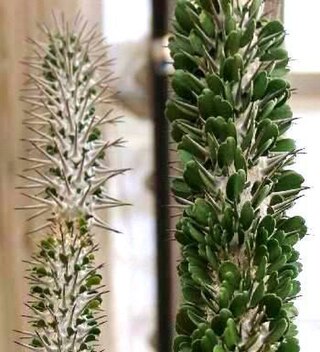
Didiereaceae is a family of flowering plants found in continental Africa and Madagascar. It contains 20 species classified in three subfamilies and six genera. Species of the family are succulent plants, growing in sub-arid to arid habitats. Several are known as ornamental plants in specialist succulent collections. The subfamily Didiereoideae is endemic to the southwest of Madagascar, where the species are characteristic elements of the spiny thickets.
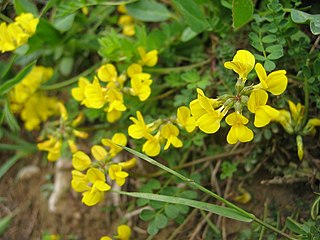
Hippocrepis comosa, the horseshoe vetch, is a species of perennial flowering plant belonging to the genus Hippocrepis in the family Fabaceae.

The Marcgraviaceae are a neotropical angiosperm family in the order Ericales. The members of the family are shrubs, woody epiphytes, and lianas, with alternate, pinnately nerved leaves. The flowers are arranged in racemes. The flowers are accompanied by modified, fleshy, saccate bracts which produce nectar. The flowers are pentamerous. The fruits are capsules.

The green-crowned brilliant is species of hummingbird in the "brilliants", tribe Heliantheini in subfamily Lesbiinae. It is found in Colombia, Costa Rica, Ecuador, and Panama. It is also known as the green-fronted brilliant.

Thomas's nectar bat is a bat species from South and Central America. Thomas's nectar bat pollinates the vine Marcgravia.

Hippocrepis is a genus of flowering plants in the legume family, Fabaceae. It includes 34 species native to Europe, northern Africa, and western Asia.
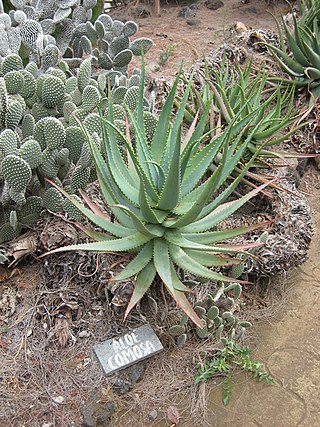
Aloe comosa is a species of flowering plant in the Asphodelaceae family. It is commonly called Clanwilliam aloe) and is endemic to South Africa.
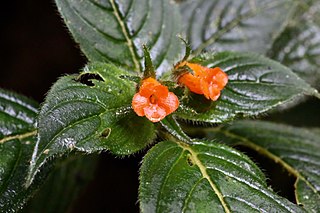
Besleria comosa is a species of plant in the family Gesneriaceae. It is endemic to Ecuador. Its natural habitats are subtropical or tropical moist lowland forests and subtropical or tropical moist montane forests.
Marcgravia crassiflora is a species of flowering plant in the Marcgraviaceae family. It is endemic to Ecuador.

Marcgravia is a genus of plants in the Marcgraviaceae family commonly eaten by the dwarf little fruit bat. The genus is native to the Caribbean Islands, Central America, and South America, and genus is named in memory of the German naturalist Georg Marcgraf. The plant is visited by Thomas's nectar bat.
Marcgravia grandifolia is a species of plant in the Marcgraviaceae family. It is endemic to Ecuador.
Marcgravia polyadenia is a species of plant in the Marcgraviaceae family. The flowering vine is endemic to Ecuador.
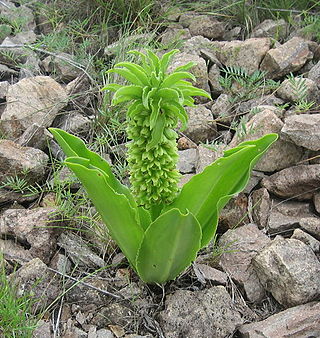
Eucomis is a genus of flowering plants in the family Asparagaceae, subfamily Scilloideae, native to southern Africa. Most species of this genus are commonly referred to as pineapple flowers or pineapple lilies. They are bulbous perennials with basal rosettes of leaves and stout stems covered in star-shaped flowers with a tuft of green bracts at the top, superficially resembling a pineapple – hence the common names.
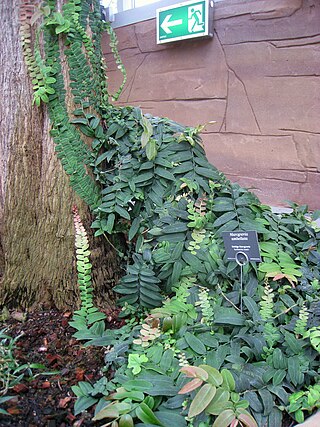
Marcgravia umbellata, also called monkey paws, is a species of flowering vine in the family Marcgraviaceae. It is native to the Lesser Antilles islands in the eastern Caribbean and Anguilla. They are part of the guild photoautotroph. Marcgravia umbellata was the first member of the marcgraviaceae family to be described in modern botanical literature.

Leopoldia comosa is a perennial bulbous flowering plant in the family Asparagaceae. Usually called the tassel hyacinth or tassel grape hyacinth, it is one of a number of species and genera also known as grape hyacinths. It is found in rocky ground and cultivated areas, such as cornfields and vineyards in the Mediterranean region, but has naturalized elsewhere. In southern Italy and Greece, its bulb is a culinary delicacy.
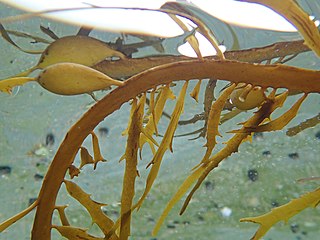
Phyllospora comosa, known as crayweed, is a species of brown algae in the Seirococcaceae family that is a type of temperate seaweed forest important as habitat for many marine species and also for producing oxygen and capturing atmospheric carbon. It is found in the oceans around Australia and New Zealand. Crayweed grows up to 2.5 m in length and forms dense, shallow forests. It is abundant in cooler waters along the south-eastern coastline of Australia, around Tasmania and in South Australia and occurs to a depth of around five metres (16 ft) on the east coast and farther south to about three metres (9.8 ft). On some Tasmanian coasts it can occur depths of at 18 metres (59 ft). It used to occur around Sydney but has disappeared from metropolitan areas under pressure from human activities during the 1970s and 1980s.
Graphops comosa, known generally as the Monahans sandhill chrysomelid or long-haired graphops, is a species of leaf beetle. It is found in southeast New Mexico and the adjacent region of Texas.
Marcgravia dressleri is a species of Marcgravia. Marcgravia dressleri is native to Colombia.
Marcgravia caudata is a species of Marcgravia native to Bolivia. It belongs to Marcgraviaceae family.












